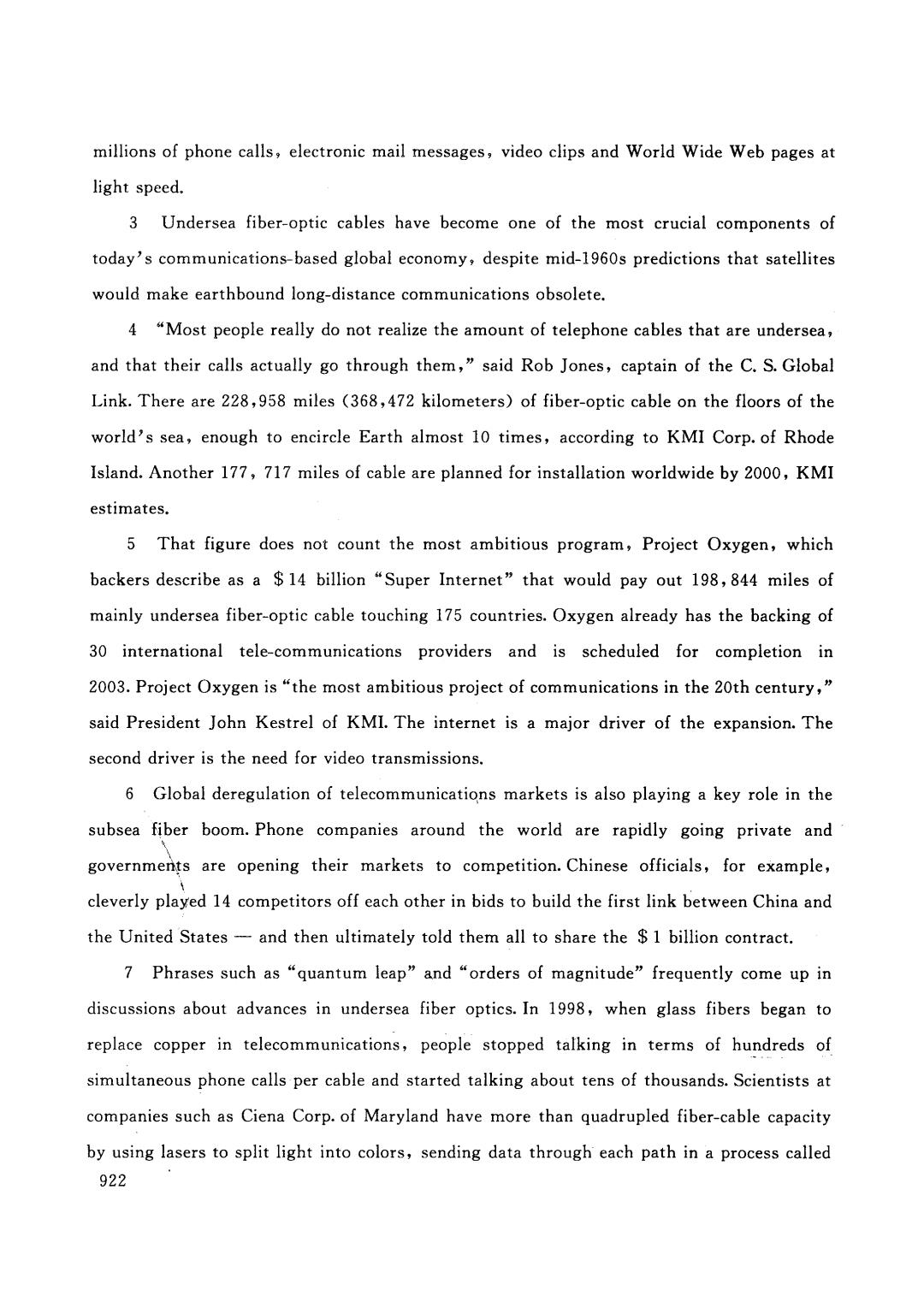正在加载图片...

millions of phone calls,electronic mail messages,video clips and World Wide Web pages at light speed. 3 Undersea fiber-optic cables have become one of the most crucial components of today's communications-based global economy,despite mid-1960s predictions that satellites would make earthbound long-distance communications obsolete. 4 "Most people really do not realize the amount of telephone cables that are undersea, and that their calls actually go through them,"said Rob Jones,captain of the C.S.Global Link.There are 228,958 miles (368,472 kilometers)of fiber-optic cable on the floors of the world's sea,enough to encircle Earth almost 10 times,according to KMI Corp.of Rhode Island.Another 177,717 miles of cable are planned for installation worldwide by 2000,KMI estimates. 5 That figure does not count the most ambitious program,Project Oxygen,which backers describe as a $14 billion "Super Internet"that would pay out 198,844 miles of mainly undersea fiber-optic cable touching 175 countries.Oxygen already has the backing of 30 international tele-communications providers and is scheduled for completion in 2003.Project Oxygen is "the most ambitious project of communications in the 20th century, said President John Kestrel of KMI.The internet is a major driver of the expansion.The second driver is the need for video transmissions. 6 Global deregulation of telecommunications markets is also playing a key role in the subsea fiber boom.Phone companies around the world are rapidly going private and governments are opening their markets to competition.Chinese officials,for example, cleverly played 14 competitors off each other in bids to build the first link between China and the United States-and then ultimately told them all to share the 1 billion contract. 7 Phrases such as“quantum leap”and“orders of magnitude”frequently come up in discussions about advances in undersea fiber optics.In 1998,when glass fibers began to replace copper in telecommunications,people stopped talking in terms of hundreds of simultaneous phone calls per cable and started talking about tens of thousands.Scientists at companies such as Ciena Corp.of Maryland have more than quadrupled fiber-cable capacity by using lasers to split light into colors,sending data through each path in a process called 922millions of phone calls, electronic mail messages, video clips and World Wide Web pages at light speed. 3 Undersea fiber-optic cables have become one of the most crucial components of today' s communications-based global economy , despite mid-1960s predictions that satellites would make earthbound long-distance communications obsolete. 4 "Most people really do not realize the amount of telephone cables that are undersea , and that their calls actually go through them ," said Rob Jones, captain of the C. S. Global Link. There are 228 ,958 miles (368 ,472 kilometers) of fiber-optic cable on the floors of the world' s sea , enough to encircle Earth almost 10 times, according to KMI Corp. of Rhode Island. Another 177 , 717 miles of cable are planned for installation worldwide by 2000 , KMI estImates. 5 That figure does not count the most ambitious program , Project Oxygen , which backers describe as a $ 14 billion "Super Internet" that would payout 198 , 844 miles of mainly undersea fiber-optic cable touching 175 countries. Oxygen already has the backing of 30 international tele-communications providers and is scheduled for completion in 2003. Project Oxygen is "the most ambitious project of communications in the 20th century ," said President John Kestrel of KMI. The internet is a major driver of the expansion. The second driver is the need for video transmissions. 6 Global deregulation of telecommunicati~ns markets is also playing a key role in the subsea fiber boom. Phone companies around the world are rapidly going private and govmmks are opening their markets to competition.Chinese officials,for example , cleverly played 14 competitors off each other in bids to build the first link between China and the United States - and then ultimately told them all to share the $ 1 billion contract. 7 Phrases such as "quantum leap" and "orders of magnitude" frequently come up in discussions about advances in undersea fiber optics. In 1998 , when glass fibers began to replace copper in telecommunications , people stopped talking in terms of hundreds of simultaneous phone callsper cable and started talking about tens of thousands. Scientists at companies such as Ciena Corp. of Maryland have more than quadrupled fiber-cable capacity by using lasers to split light into colors, sending data through each path in a process called • 922